Physical Address
304 North Cardinal St.
Dorchester Center, MA 02124
Lateral and medial epicondylitis are common elbow tendinopathies involving tendon origins that most commonly present in middle age. These are typically self-limited, with a multitude of conservative and operative options described. In contrast, biceps and triceps tendinitis are insertional tendinopathies. Finally, olecranon bursitis is an inflammation of the dorsal bursa at the elbow. This chapter will evaluate the literature and current evidence about diagnostic maneuvers and treatment options to allow the sports physician to effectively treat patients with these problems.
Initially described secondary to lawn tennis, lateral epicondylitis affects approximately 3% of the population during some point in their lives. It is far more common than medial epicondylitis, with a 3 to 6 : 1 ratio. Patients with lateral and medial epicondylitis present with complaints of pain on the respective side of the elbow. Also known as tennis elbow (lateral) or golfer's elbow (medial), these entities present most commonly in persons between 30 and 50 years of age. Men and women are equally affected, with a higher occurrence rate in non-athletes.
Symptoms are typically insidious in onset, although some patients develop complaints after a traumatic incident. The pathophysiology of lateral epicondylitis has been shown to involve the origin of the extensor carpi radialis brevis (ECRB) tendon, with infiltration of vascular buds and fibroblast proliferation termed “angiofibroblastic hyperplasia.” Another histologic evaluation noted vascular proliferation and hyaline degeneration, without an inflammatory response. Occasionally, the extensor digitorum communis and extensor carpi radialis longus may also be involved. The most common presenting complaint is pain with lifting. As many activities of daily lifting are performed with the forearm in neutral rotation, lifting in this position requires slight wrist extension, which may cause overuse or microtears of the ECRB tendon origin as the source of pain. Nirschl et al. classified lateral epicondylitis by pathologic and pain phases as a guide to the severity of the problem ( Table 61.1 ).
| Pathology Staging Score | Pain Phase Score |
|---|---|
|
|
|
|
|
|
|
|
Medial epicondylitis is less common and is not well understood. Patients complain of an insidious onset of pain at the medial aspect of the elbow. Risk factors for medial epicondylitis are similar to those of lateral epicondylitis and include repetitive overuse and obesity. At surgery, Gabel and Morrey observed a nidus of granulation tissue at the flexor-pronator origin overlying the pronator teres and flexor carpi radialis origin. They noted that this entity often overlaps with symptomatic ulnar nerve compression.
On examination of the patient with tennis elbow, patients are typically tender at or just distal to the lateral epicondyle with palpation. The most characteristic examination maneuver is the provocation of pain at the lateral elbow with resisted wrist extension of the patient's fist, forearm pronated and the elbow fully extended ( Fig. 61.1 ). The Cozen test is a similar maneuver, except that the examiner grasps the elbow to stabilize it while asking the patient to extend the clenched fist against resistance. To rule out posterolateral rotatory instability due to lateral ulnar collateral ligament injury, the posterolateral rotatory drawer test is performed. This is done with the patient supine, with the arm overhead and held externally rotated; the examiner stabilizes the humerus with one hand and applies a posterolateral rotatory stress by grasping the forearm and attempting to push the radial head posteriorly.
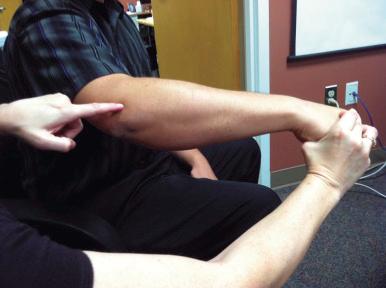
At the medial elbow, patients have tenderness at the flexor-pronator origin at the medial epicondyle. Pain with resisted forearm pronation is felt to be the most sensitive test for medial epicondylitis, while pain with resisted wrist flexion may also be indicative. Because of the overlap of medial epicondylitis and ulnar nerve compression, Tinel's testing over the ulnar nerve posterior to the medial epicondyle should be performed. Gabel and Morrey classified medial epicondylitis by the degree of ulnar nerve involvement, as follows: type IA with no symptoms of ulnar nerve compression; type IB with mild ulnar nerve symptoms; and type II with moderate or severe ulnar nerve compression in association with medial epicondylitis. The medial collateral ligament should be examined to rule out instability with valgus load applied to the elbow at 30 degrees of elbow flexion.
Differential diagnosis of these conditions includes radial tunnel syndrome, characterized by aching pain in the proximal forearm distal to the lateral epicondyle with many similar positive provocative tests, medial triceps tendinitis or snapping, and injury or sprain to the lateral and medial collateral ligaments. In addition, neurologic conditions such as pronator syndrome and cubital tunnel syndrome as well as elbow pathologies such as plica, osteochondral defects, and joint degeneration need to be considered.
Tennis and golfer's elbow are primarily clinical diagnoses, and the role of imaging is to rule out other conditions about the elbow. Plain radiographs are typically normal, with faint calcifications occasionally seen at the tendon origin ( Fig. 61.2 ). Pomerance evaluated 294 radiographs in patients diagnosed with lateral epicondylitis and noted that 7% had this finding; however, radiographic findings changed management only twice, for patients noted to have osteochondritis dissecans who went on to surgical treatment for this diagnosis.
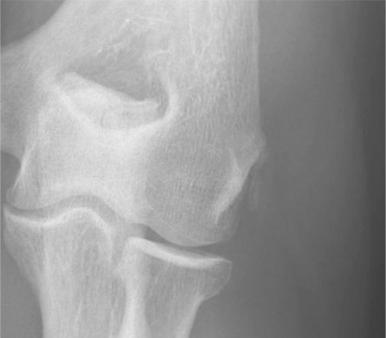
Ultrasound has been used to evaluate the tendon origin, with findings of decreased echogenicity and peritendinous soft tissue thickening. Abnormalities of the deep fibers of the ECRB may also be visualized. A recent systematic review of 15 diagnostic studies confirmed the utility of gray-scale ultrasound in identification of hypoechogenicity and bone changes at the lateral epicondyle ( Fig. 61.3 ). Heales et al. reported a case-control comparison of ultrasound of patients with lateral epicondylitis, interpreted by blinded radiologists, and noted a sensitivity of 90% and specificity of 47% when greyscale and power Doppler imaging were combined. Magnetic resonance imaging (MRI) may show signal changes at the ECRB origin on T1-weighted images, with fluid or thinning seen at the tendon origin on T2 images, interpreted as enthesopathy or partial tear ( Fig. 61.4 ). van Kollenburg et al. noted that patients with lateral epicondylitis were significantly more likely to have signal changes interpreted as ECRB tendinosis on MRI than controls ( P < .001), but that both groups had similar proportions of signal changes in the lateral collateral ligament and reading of partial ECRB defect. The same group also evaluated MRI reports of 3374 patients, noting that signal change in the ECRB was common in both symptomatic and asymptomatic elbows, and the incidence of signal change increased over time with increasing age. A recent study suggests that the role of MRI is not for diagnostic or prognostic information but rather to rule out pathology in equivocal or recalcitrant cases of epicondylitis.
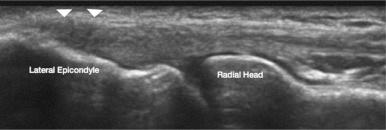
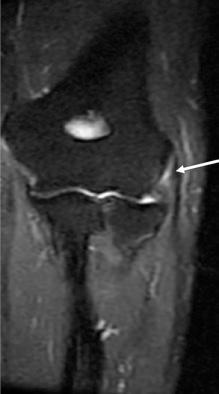
Because the treatment of epicondylitis is primarily nonsurgical, decision-making is based on a discussion with the patient about the evidence regarding various treatment options. It is important for the patient to know that no matter what treatment is chosen, epicondylitis often takes a long time to resolve. Given that no one particular treatment method or algorithm has universal acceptance or been deemed superior to another in these conditions, patients are often initially managed nonoperatively with special considerations given to the individual's vocational and avocational activities. Avoidance of a known aggravating activity is likely where treatment should begin. The remaining methods of treatment are designed to alleviate or reduce symptoms, although their effect may not be immediate or curative. Surgery for epicondylitis is considered as a last resort after other treatments have failed. Although many retrospective studies have reported good outcomes for surgery, more recent meta-analyses have not been able to support a definitive role for surgery for epicondylitis, as the outcomes can be unpredictable.
There is increasing evidence that lateral and medial epicondylitis are self-limited entities that resolve on their own over time. Smidt et al. performed a randomized controlled trial comparing corticosteroid injection, physiotherapy, or a wait-and-see approach in 185 patients in the Netherlands. At 1 year, success rates were 69% for injections, 91% for therapy, and 83% for wait-and-see, with no significant differences between therapy and observation (see Fig. 61.2 ). Szabo has recommended reassurance that continued use of the arm will not damage or worsen the tendinosis, and emphasis of the self-limited nature of lateral or medial epicondylitis.
The use of a forearm support band or tennis elbow strap has been proposed to reduce stress at the ECRB tendon origin. Meyer et al. noted in a cadaver study that increased band compression caused concomitant force reduction at the ECRB origin. Others noted that wearing a support band increased the rate of fatigue of the wrist extensors, and recommended against their use. A recent randomized trial comparing a forearm band and extensor strengthening exercises showed that both groups improved with time, with no differences between them.
The use of wrist splinting has also been described, with the hypothesis of decreasing the stretch and use of the ECRB. Van de Streek compared a forearm splint to elbow band treatment in 43 patients in a randomized trial and noted no differences in grip or pain after 6 weeks, concluding that both showed some effect. Another randomized trial in 42 patients comparing wrist extension splinting to counterforce strap noted significantly better pain relief with the splint, although there was no difference in measures of function, including the Mayo Elbow Performance score or American Shoulder and Elbow Society (ASES) scores.
The use of deep massage, eccentric exercises, strengthening, ultrasound, and iontophoresis have all been proposed as part of therapeutic interventions for epicondylitis; however, there is limited evidence to support one as superior. In Smidt's study comparing therapy, injection, and observation, physiotherapy had the highest success rate at 1 year. The modality of friction massage was described by Cyriax to relieve pain and increase blood flow. A recent randomized trial showed superior results with a supervised exercise program compared to Cyriax physiotherapy for tennis elbow, although both groups improved with respect to pain and function. A meta-analysis evaluating exercise in the treatment of epicondylitis showed that resistance exercises resulted in improvement in tennis elbow symptoms, with eccentric stretching being the most studied. A randomized trial comparing eccentric to concentric exercise showed the largest decrease in pain when eccentric and concentric contractions were combined with isometric exercises.
Ultrasound is thought to provide benefit through deep heating of tissues. Binder et al. noted a significant difference in lateral epicondylitis patients treated with ultrasound compared to placebo treatment; however, later randomized trials have shown no differences between ultrasound and sham-ultrasound treated groups. A recent randomized trial comparing exercise and therapeutic ultrasound to corticosteroid injection in 49 subjects demonstrated significant improvement in pain and function in the exercise group at 12 weeks.
Iontophoresis delivers water-soluble medications such as dexamethasone or saline through the skin with the use of electrical current. Stefanou et al. noted short-term benefit of dexamethasone iontophoresis in a randomized study with comparison to injection of dexamethasone. In a double-blind comparison study, however, Runeson and Haker noted no significant differences in 64 patients randomized to iontophoresis or placebo.
Multiple types of injections have been used for the treatment of epicondylitis. The most common is corticosteroid injection, which has been shown in systematic reviews to have a short-term effect on pain relief for up to 6 weeks (see Fig. 61.3 ). Given that epicondylitis is a noninflammatory condition, the mechanism of action of steroid injection is uncertain. Randomized trials and a recent meta-analysis of corticosteroid versus placebo injection for tennis elbow showed no differences in outcomes as measured by either Disabilities of the Arm, Shoulder, and Hand (DASH) or pain scores.
There has been recent interest in injections of whole blood and platelet-rich plasma (PRP), with the purported mechanism of stimulating reversal of the angiofibroblastic tendinosis by the delivery of humoral mediators and growth factors. Whole or autologous blood contains these factors, and separating blood components by centrifugation to inject plasma concentrates the solution. Edwards and Calandruccio initially described pain relief and functional improvement in two-thirds of a group with chronic lateral epicondylitis treated with one or two autologous blood injections in a retrospective study. Studies of PRP in lateral epicondylitis have shown mixed results, with some randomized trials showing significantly better results compared to corticosteroid, while others demonstrated no differences among PRP, corticosteroids, or placebo saline. A recent systematic review and network analysis comparing injections of autologous blood to PRP showed comparable outcomes, with both injection types being superior to steroid injections, with a higher risk of complications with autologous blood injection.
Less commonly used injections include botulinum toxin and prolotherapy. Botulinum works by temporary paralysis of the extensor origin, and limited studies have shown effective results in decreasing pain. A randomized multicenter trial showed significantly better results with botulinum injection compared to placebo at 18 weeks, although middle finger extension was weakened by the botulinum temporarily. A different formulation, prolotherapy, consists of either hypertonic glucose or saline injected into the ECRB origin in an effort to sclerose pathologic neovascularization and provide a toxic effect on granulation tissue. While evidence is limited, a recent randomized trial comparing prolotherapy to corticosteroid showed improvement in both groups without significant differences between them.
There are several surgery options for epicondylitis, typically reserved for patients who have failed extensive nonoperative treatment, which include open or arthroscopic débridement, extensor release or repair, extensor repair, and denervation. The classic surgical approach to lateral epicondylitis is termed the “Nirschl procedure” and involves open débridement of all identifiable granulation and/or fibrous tissue at the ECRB origin, ( Fig. 61.5 ) followed by decortication or drilling of the lateral epicondyle prominence to improve blood supply. The overlying fascial edges of the extensor carpi radialis longus and extensor digitorum communis are closed.
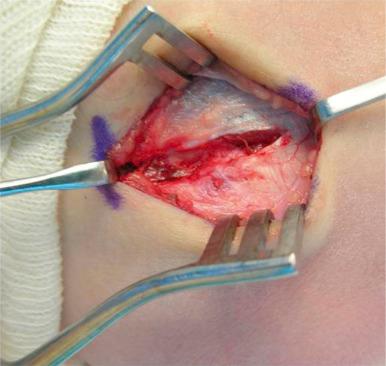
Other authors have described percutaneous or open release of the extensor origin down to the capsule of the elbow, after which the extensors are allowed to retract distally. The extensor muscular origin is attached at multiple points to the surrounding fascial bands and to underlying joint capsule, and thus extensor weakness is not observed after this procedure. A recently described alternative is the use of ultrasound-guided instrumentation to perform microresection and tenotomy at the tendon origin. A retrospectively evaluated cohort of 20 patients showed significant reduction in pain and improved function at 3-year followup.
An alternate procedure involves débridement of devitalized tissue and repair of the ECRB to the lateral epicondyle using suture anchors or bone tunnels. Additionally, denervation of the lateral elbow has been described by Kaplan and others, with careful dissection and division of multiple cutaneous radial nerve branches while preserving the posterior interosseous nerve (PIN).
Arthroscopic management of lateral epicondylitis has been demonstrated, with débridement and release of the underside origin of the ECRB. The proposed advantages of arthroscopy are that it is minimally invasive and is able to manage concomitant intra-articular pathology, which has been seen in up to one-third of patients. It is only necessary to access the anterior compartment of the elbow, with use of a modified anterolateral portal established using an inside-out technique, starting 2 to 3 cm proximal and anterior to the lateral epicondyle. Synovitis, identified at the tendon origin and lateral capsule, is débrided using a shaver. The ECRB is then released using monopolar thermal dissection or a shaver, taking care to limit the release to the area anterior to the midline of the radiocapitellar joint in order to preserve the lateral collateral ligament origin. Some surgeons will drill the epicondyle, or débride the exposed underside using an arthroscopic burr.
At the medial epicondyle, it is necessary to first identify and protect the ulnar nerve. The nerve is typically decompressed in situ through a mini-incision, and a limited débridement of the underside of the flexor pronator origin is performed using a shaver. During débridement, the ulnar nerve is retracted medially to protect it.
My management of lateral or medial epicondylitis begins with a discussion of the evidence for and against the multiple treatment options. I emphasize the typical self-limited nature of the condition and caution that this tendinosis may remain symptomatic up to 1 to 2 years before resolving, except in a small number of people. I also reassure patients that they are not causing themselves harm or damage by using the arm, and that they are not causing joint instability or tissue damage that will lead to disability. For each patient, I demonstrate eccentric stretching exercises for tendinosis, and discuss that this expectant treatment alone can be sufficient to treat epicondylitis.
I offer referral to therapy and discuss injection options. I always emphasize the limited course of pain relief from steroid injections, approximately 6 weeks in length, but will give one at a patient's request. For patients presenting with greater than 6 months of symptoms and especially with chronic epicondylitis, I will offer an autologous blood injection, as my anecdotal experience has shown that this work bests in that patient group.
For surgical management of lateral epicondylitis, I perform the Nirschl procedure with open débridement of the ECRB origin. This is typically done under Bier block anesthesia, with a longitudinal incision over the lateral epicondyle and ECRB origin. The fascia is incised with retraction of the extensor carpi radialis longus and extensor digitorum communis, exposing the deep ECRB. The origin is débrided of any gray, shiny tissue to leave healthy tendon behind. I typically do not open the elbow joint. I use a rongeur or osteotome to decorticate the prominence of the lateral epicondyle, taking care not to go too inferiorly to protect the origin of the lateral collateral ligament. Sometimes, there may be some degenerative changes on the undersurface of the extensor digitorum communis, which I also débride, as failure to do so may lead to suboptimal results. After irrigation, the fascia of the extensor carpi radialis longus (ECRL) and extensor digitorum communis (EDC) is closed using 2-0 resorbable sutures, and the skin is then closed using a resorbable monocryl subcuticular suture.
For medial epicondylitis, I perform an open débridement of the flexor-pronator origin, focusing on the interval between the pronator teres and the flexor carpi radialis at their attachment to the medial epicondyle. While not typically able to visualize a nidus of abnormal tissue as advocated by Gabel and Morrey, I remove any devitalized tissue at the origin and decorticate the medial epicondyle with a rongeur. Closure and other management are similar to my treatment of lateral epicondylitis.
The patient is splinted postoperatively for 2 weeks and then begins therapy for 4 to 6 weeks with a 5-lb lifting limit. Strengthening is begun at 6 weeks, and return to heavy lifting and strenuous sports is not permitted until 3 months.
Resumption of athletic activities is sport-dependent after surgery for lateral or medial epicondylitis. Strenuous or contact sport activity is permitted at 3 months if the patient has tolerated the strengthening phase of rehabilitation. Earlier return, typically at 6 weeks, is allowed for individual sports such as golf, skiing, and swimming, with the elbow taped or supported as necessary.
For nonoperatively treated patients, return to sport is allowed at their tolerance, with the understanding that the elbow may be painful with certain motions or after heavy use.
Dunn et al. reported 10 to 14-year follow-up of the Nirschl open débridement technique in 139 patients in a retrospective review. The authors noted decreased pain scores and improved American Shoulder and Elbow Surgeons’ scores, with 84% good to excellent results combining two other functional scales, and 93% of patients who were able to return to sports. A prospective randomized comparative study between percutaneous and open ECRB release showed improvements in both groups, but the percutaneous-release group had significantly better DASH scores, improvement in sports performance, and earlier return to work. Ruch et al. compared open débridement with and without anconeus flap rotation in 57 patients and noted significantly better DASH scores in the group treated with anconeus rotation, but no other differences at 7-month follow-up. A recent Cochrane review of the available evidence for surgical treatment concluded that there was insufficient evidence to support the use of surgical treatment for lateral epicondylitis or the application of one surgical technique as superior.
Lattermann et al. noted improvement of pain and function scores in a retrospective review of 36 patients treated arthroscopically, although 31% noted mild pain with strenuous activities. Other authors have noted similar positive findings, although heavy laborers and worker's compensation claimants had overall worse outcomes. Szabo et al. compared open, arthroscopic, and percutaneous release of the ECRB in a group of 109 patients with 47.8-month mean follow-up. The authors noted that there was significant improvement in Andrews-Carson scores from pre- to postoperative evaluation, with no differences between groups, and concluded that all three procedures were highly effective in treating lateral epicondylitis. A recent retrospective comparison of arthroscopic to open ECRB débridement showed similar improvement in both groups, but the open procedure cohort had a significantly better pain visual analogue scale (VAS) score during hard or heavy work compared to the arthroscopic group.
The majority of reports of treatment for medial epicondylitis involve open débridement of the flexor-pronator origin in patients who have failed lengthy conservative management. Gabel and Morrey noted excellent outcomes in a retrospective review of 26 elbows treated for medial epicondylitis, reporting significantly better results in patients without concomitant ulnar nerve compression neuropathy. A recent retrospective evaluation of 55 patients treated surgically with débridement, medial epicondylectomy, and ulnar nerve release showed significant improvement in pain, grip strength, and DASH and Mayo scores at a minimum 5-year follow-up. Zonno et al. performed a cadaveric study to evaluate the safety of arthroscopic débridement of medial epicondylitis, but this technique has not been reported in clinical studies to date.
A notable complication of nonoperative treatment is soft tissue atrophy, skin thinning, and hypopigmentation after corticosteroid injections, which is a risk that should be addressed when treating patients with this modality. Subcutaneous injection should be avoided to minimize this complication, and repeated injections increase the risk of atrophy.
Surgical complications include posterolateral rotatory instability if the lateral collateral ligament is damaged in the approach to the common extensors. Kalainov et al. noted this complication after corticosteroid injection in three elbows. The risk of this complication is minimized by taking care not to dissect too far posteriorly on the lateral epicondyle during the surgical approach. Other reported complications are rare, including development of synovial fistulae and transient paresthesias.
Short-term evidence supports expectant treatment of epicondylitis, with assurance to the patient that this self-limited entity tends to resolve over time. There is a subset of patients, however, who do not resolve their symptoms, eventually leading to surgical treatment. Identification of this group is a focus of continued study. The current evidence for conservative treatment of medial and lateral epicondylitis is strong, with surgery reserved for those who have failed multiple modalities. Potential future considerations include refinement of biologic treatments such as autologous blood and PRP, as well as exploration of the neurologic contributions in patients with chronic epicondylitis.
Become a Clinical Tree membership for Full access and enjoy Unlimited articles
If you are a member. Log in here